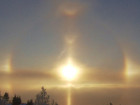|
Asteroids, meteors, and meteorites
|
|
| HarbingerDawn | Date: Saturday, 18.05.2013, 20:41 | Message # 106 |
 Cosmic Curator
Group: Administrators
 United States
United States
Messages: 8717
Status: Offline
| This one was moving at 25 km/s. Generously assuming that it hit at a 20° angle do you think it would be likely to produce any meteorites?
All forum users, please read this!
My SE mods and addons
Phenom II X6 1090T 3.2 GHz, 16 GB DDR3 RAM, GTX 970 3584 MB VRAM
|
| |
| |
| midtskogen | Date: Sunday, 19.05.2013, 09:03 | Message # 107 |
 Star Engineer
Group: Users
 Norway
Norway
Messages: 1674
Status: Offline
| I don't know what angle would separate vapour and dust from meteorite given speed and composition. A favourable angle for this one would produce the typical meteorites that are never found, though. Relatively small and big meteoroids may produce meteorites, but the bigger ones produce a lot more of them (and therefore are more often found) though relatively less of the original material survives.
NIL DIFFICILE VOLENTI

|
| |
| |
| neutronium76 | Date: Tuesday, 21.05.2013, 10:26 | Message # 108 |
 World Builder
Group: Users
 Greece
Greece
Messages: 718
Status: Offline
| This one came into my attention while reading the news:
I wonder what would happen if it hit earth  ... ...
PC1:Core i7 970@3.34GHz, 6 cores/12 threads, 12GB DDR3 RAM@1.34GHz, 2x(SLI) GTX-580 GPUs 3GB VRAM(GDDR5)@1GHz, OS:Win7x64SP1
PC2:Core2Quad X9770@3.2GHz, 2 cores/4 threads 4GB DDR2 RAM@1GHz, GTX-285 GPU 1GB VRAM(DDR3)@1.24GHz, OS:WinVistax64SP2
Edited by neutronium76 - Tuesday, 21.05.2013, 10:27 |
| |
| |
| HarbingerDawn | Date: Tuesday, 21.05.2013, 10:46 | Message # 109 |
 Cosmic Curator
Group: Administrators
 United States
United States
Messages: 8717
Status: Offline
| Quote (neutronium76) I wonder what would happen if it hit earth
It would destroy virtually everything within hundreds of kilometers of its impact site, and if it landed in the ocean it would also produce an enormous tsunami. Such an asteroid could easily destroy an entire country or region.
All forum users, please read this!
My SE mods and addons
Phenom II X6 1090T 3.2 GHz, 16 GB DDR3 RAM, GTX 970 3584 MB VRAM
|
| |
| |
| HarbingerDawn | Date: Friday, 31.05.2013, 13:17 | Message # 110 |
 Cosmic Curator
Group: Administrators
 United States
United States
Messages: 8717
Status: Offline
| 1998 QE2, a 2.7-kilometer-wide asteroid which will soon make a relatively close pass to Earth, has been discovered to have a companion, a small moon about 200 meters wide. This does not make it very unusual though; 16% of near-Earth asteroids over 200 meters wide are part of double- or triple-object systems.
http://www.space.com/21371-asteroid-1998qe2-moon-images.html
All forum users, please read this!
My SE mods and addons
Phenom II X6 1090T 3.2 GHz, 16 GB DDR3 RAM, GTX 970 3584 MB VRAM
|
| |
| |
| Watsisname | Date: Saturday, 08.06.2013, 06:11 | Message # 111 |
 Galaxy Architect
Group: Global Moderators
 United States
United States
Messages: 2613
Status: Offline
| Binary asteroids are cool.  If I recall rightly there's also a few examples of craters on the Earth that were formed by the impact of binary asteroids. They're not as common to see though, since if the binary was not widely separated enough then it still just looks like one crater. If I recall rightly there's also a few examples of craters on the Earth that were formed by the impact of binary asteroids. They're not as common to see though, since if the binary was not widely separated enough then it still just looks like one crater.

|
| |
| |
| midtskogen | Date: Friday, 14.06.2013, 22:45 | Message # 112 |
 Star Engineer
Group: Users
 Norway
Norway
Messages: 1674
Status: Offline
| Norway's 16th meteorite was found a few days ago. I possibly got it on video as a fireball last year, and if this is the case, it's the first meteorite found in Norway to have been photographed as a fireball. Story here:
http://norskmeteornettverk.no/wordpress/?p=487
(Use google translate) EDIT: It's horrible.
4.7 kg chondrite. Possibly H-chondrite. Note the nice little impact "crater". I'm not sure if it tells anything about the time of the year when it fell. In winter the ground should be frozen, but on the other hand, snow might insulate preventing frost, and if it's loose enough, it wont stop a meteorite at all. In any case the force of something nearly 5 kg at 300 km/h isn't insignificant, and could perhaps dent frozen ground. It was found in a marshy area. One could argue that it should have gone deeper if it was in summer.
NIL DIFFICILE VOLENTI

Edited by midtskogen - Friday, 14.06.2013, 22:52 |
| |
| |
| HarbingerDawn | Date: Friday, 14.06.2013, 23:14 | Message # 113 |
 Cosmic Curator
Group: Administrators
 United States
United States
Messages: 8717
Status: Offline
| Wow, that's quite a bright fireball. Congrats on your contribution to this discovery Midtskogen 
All forum users, please read this!
My SE mods and addons
Phenom II X6 1090T 3.2 GHz, 16 GB DDR3 RAM, GTX 970 3584 MB VRAM
|
| |
| |
| Watsisname | Date: Saturday, 15.06.2013, 01:16 | Message # 114 |
 Galaxy Architect
Group: Global Moderators
 United States
United States
Messages: 2613
Status: Offline
| Yes indeed, that's pretty exciting! Do we know where the meteorite was (will be?) sent to? The article seems to mention a natural history museum.

|
| |
| |
| midtskogen | Date: Saturday, 15.06.2013, 18:32 | Message # 115 |
 Star Engineer
Group: Users
 Norway
Norway
Messages: 1674
Status: Offline
| Thank you. I have nothing to do with the discovery of the meteorite, which was by chance. However, if we have photos of it as a fireball, that will have scientific value.
When I recorded this fireball in February last year, I first mostly dismissed it because it was pretty short lived, just 3.3 seconds. And it was not exceptionally bright either. But then there also were a couple of all sky cameras in Denmark that had recorded it as well (but at greater distance and less resolution). That had it falling pretty steep at 60 degrees towards the ground appearing at an altitude of 68 km going down to about 31 km, and the speed seemed to be as low as 13 km/s. A pretty low first appearance but it was slow and the cameras were distant. The new data greatly increased the possibility of something reaching the ground. Many people saw it from far away (often described as fireworks landing a few hundred meters away). But the actual area it passed over is sparsely populated. It was nothing I would recommend people actively to search for, though. I then estimated that fallout would be around a place about 30 km from where the meteorite was found. Looking at the data again, I still roughly get the same place 20-30 km away, but the bearings from the three photographs don't quite add up though it is certain that they recorded the same event. So there are inaccuracies. The camera distances are pretty long as well, between 200 and 300 km. I think it's hard to say that it is the same meteorite or say that it isn't. It would be great if more pieces are found and check whether the line in which they're found matches. That should decide it. The Oslo camera sees it almost dead head on.
Yes, the meteorite is currently at the museum of Natural history in Oslo. The finder has donated the smaller piece to the museum and will consider selling the other piece. The museum might buy it. The market value is hard to estimate, perhaps $20,000. It's not a fresh meteorite and water has penetrated it, though. In any case it will be examined scientifically.
It would be really exciting if this is the meteor that was photographed. It was the very fireball which had me starting to record these events more carefully, and we then can say that it also was an event that helped establishing the Norwegian meteor network this winter.
EDIT: I will translate the article, but wont have time before late today.Added (15.06.2013, 21:32)
---------------------------------------------
Here's an English version of my article:
http://norskmeteornettverk.no/wordpress/?p=529
Coverage on Norwegian state TV:
http://tv.nrk.no/serie/dagsrevyen/nnfa19061413/14-06-2013#t=20m15s
(I'm not sure if it's viewable from abroad)
NIL DIFFICILE VOLENTI

Edited by midtskogen - Saturday, 15.06.2013, 08:02 |
| |
| |
| Watsisname | Date: Saturday, 15.06.2013, 21:38 | Message # 116 |
 Galaxy Architect
Group: Global Moderators
 United States
United States
Messages: 2613
Status: Offline
| Thanks for the translation!
Quote (I'm not sure if it's viewable from abroad) 

|
| |
| |
| smjjames | Date: Sunday, 16.06.2013, 19:59 | Message # 117 |
|
World Builder
Group: Users
 United States
United States
Messages: 913
Status: Offline
| Huge asteroid is a whole new class
Not a whole lot in the article, but still interesting.

|
| |
| |
| midtskogen | Date: Wednesday, 26.06.2013, 13:52 | Message # 118 |
 Star Engineer
Group: Users
 Norway
Norway
Messages: 1674
Status: Offline
| Quote (midtskogen) Meteorite fragments hit the ground in free fall, so there must be a fragment of some size that hit the lake in order to make a splash big enough to create a 6 meter hole. Certainly more than a few kg or it would only pinch a tiny hole or just embed itself in the ice. Above 100 kg, perhaps?
Finally lake Chebarkul is beginning to reveal its secrets:
http://www.spacedaily.com/reports....99.html
It may turn out that my guess at something above 100 kg wasn't too bad.
NIL DIFFICILE VOLENTI

|
| |
| |
| Watsisname | Date: Thursday, 27.06.2013, 01:47 | Message # 119 |
 Galaxy Architect
Group: Global Moderators
 United States
United States
Messages: 2613
Status: Offline
| Yep, that was good intuition.
I can't wait to see the thing get pulled out of there, though I haven't a clue if it would be in good condition for analysis purposes after sitting underwater all this time.

|
| |
| |
| midtskogen | Date: Thursday, 27.06.2013, 06:02 | Message # 120 |
 Star Engineer
Group: Users
 Norway
Norway
Messages: 1674
Status: Offline
| Actually, if it's true what is suggested in the article, that the last (dark) flight and impact was recorded on video, that would be something I can't wait for to see. It would be something the world hasn't seen before or anything close. Something so unique that there would be good reasons why we haven't seen it on Youtube already.
NIL DIFFICILE VOLENTI

Edited by midtskogen - Thursday, 27.06.2013, 07:05 |
| |
| |